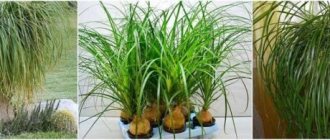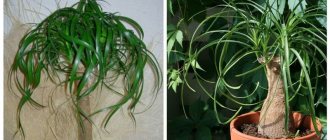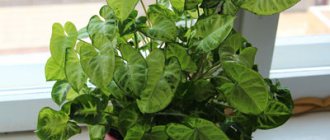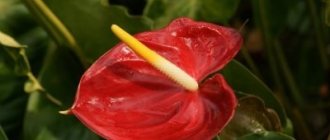Nolina is a houseplant with a very unusual appearance that immediately attracts attention. Another name for nolina is bocarnea (1), and gardeners often call it “bottle tree.” Indeed, the nolina stem has a characteristic expansion at the bottom, so it resembles a bottle. The “crown” of nolina consists of thin long leaves with a leathery surface, which grow in a bunch at the top of the trunk and give the plant a resemblance to a palm tree.
Nolina is native to Mexico and the southern United States. There it lives on poor drying soils, which is the reason for its unusual appearance. The thickening in the lower part of the trunk is a reservoir for storing moisture, and the specific shape of the leaves is needed so that the plant loses much less moisture by evaporation from their surface.
Types and varieties of nolina
Only one type of nolina flower is grown indoors - Nolina recurvata. It can reach a height of about 2 m, but usually remains more compact in indoor conditions.
On sale you can find plants with different types of formation: a single trunk with a “panicle” at the end or a branched one, each shoot of which has its own crown. These are not different varieties of nolina, but plants of the same species; the differences between them are created artificially during the growing process.
The youngest nolins look like bulbs sitting in the ground with a low crown; very often they are sold in pots of 3 pieces - over time, they most often grow together into one trunk, which gradually increases in height and takes on a characteristic “bottle” appearance.
Bottle tree - interesting facts
The amazing shape of the bottle tree attracts attention. It is equally interesting to learn some facts about nolina, bokarney or elephant's foot.
- “Smoke eater” is another name for the tree, which it received for its ability to absorb gas and smoke.
- To make a sombrero in Mexico, nolina leaves are prepared in advance.
- It is believed that keeping bocarnea in the house guarantees harmony and tranquility in the family.
- The bottle tree can extinguish outbursts of anger and aggression and help cope with stress.
- The best place for the plant is a large living room where all family members gather, or a common corridor.
Caring for nolina at home
Caring for a nolina flower is considered simple, but an inexperienced gardener may encounter a number of problems associated primarily with watering and wintering conditions for the plant (2).
Priming
As already mentioned, under natural conditions nolina lives on depleted soils, so fertile and dense soil is contraindicated for it. The soil for nolina should first of all be light, loose, water- and breathable. Ready-made compositions include mixtures for succulents and cacti, which can be enriched with charcoal or vermiculite.
If you prefer to prepare the soil yourself, then for nolina you will need a mixture of coarse sand, peat and garden soil, where sand should predominate.
Lighting
Nolina needs bright, diffused lighting and a fairly long daylight period. Direct sun, especially in summer, can harm it, but the lack of light does not have the best effect: in the shade, the nolina trunk stretches out, remains too thin and can become deformed, bending in the direction of the light.
Throughout the year, including during winter dormancy, the amount of light should be approximately the same, so caring for nolina in winter should include additional illumination with a phytolamp.
It is also useful to sometimes turn the pot so that the trunk does not bend and the crown does not become “one-sided,” since even on a light windowsill the illumination is never uniform.
Temperature
During the growing season, the plant thrives at room temperature, although in extreme heat (above 30 °C) the nolina flower may require additional care.
In the warm season, nolina can be taken out onto the balcony or terrace, taking care of protection from rain and drafts. In winter, the plant needs a rest period at a temperature of about 10 - 12 ° C, and the temperature should be lowered gradually, without sudden changes. Nolina can do without “hibernation” if the room temperature is more than 18 ° C, but the absence of a dormant period leads to the fact that the plant develops worse and lives less than it could.
Humidity
Nolina usually tolerates room humidity levels.
Plants that have not entered the dormant period may suffer from dry air in winter if they are located near heating devices or the humidity in the room is really abnormally low. In such cases, it is recommended to place the pot in a tray with damp expanded clay, pebbles or sphagnum.
Spraying and washing are not recommended; wiping the leaves with a damp cloth to remove dust is possible.
Watering
Watering is a very important point in caring for nolina. It tolerates dry soil more easily than waterlogging, so water the plant only after the earthen ball has completely dried out. Watering should be rare, but plentiful: frequent, scanty watering leads to elongation of the trunk and loss of decorativeness of the plant. Experts recommend watering the plant by immersing the pot in a basin of water so that the soil is well saturated with moisture. The water is then allowed to drain through the drainage holes and drained from the pan.
If nolina is provided with a cold winter, the plant is not watered at all or is done very rarely, only if the flower clearly shows a moisture deficiency: the trunk loses its elasticity and wrinkles.
If nolina overwinters at room temperature (18 °C and above), the watering regime remains the same as in summer, or a little less often, depending on the room temperature. As a rule, the warmer the conditions, the faster the earthen ball dries out and the more often it should be watered.
Water for irrigation should be moderately warm and low in salts, so it is advisable to settle tap water or pass it through a filter.
Fertilizers
Nolina can be fed with complex mineral fertilizers for indoor plants in half the dosage; it is advisable to use liquid formulations. Special fertilizers for cacti and succulents are also suitable.
Photo: pixabay.com
Feeding
To feed nolina, it is advisable to use liquid formulations and apply them immediately after watering once every 3-4 weeks.
It has been noticed that with a deficiency of nutrients, nolina forms a larger and thicker trunk, and with sufficient and excessive feeding, it forms abundant foliage.
Trimming
The plant does not need pruning; you just need to remove dried leaves as part of your normal nolina care.
Shaping the trunk
The decorativeness of the trunk and the appearance of the plant depend on the conditions of maintenance.
If you frequently water the nolina and place the flowerpot in a room with average lighting, the trunk will stretch out, the thickening will disappear or remain insignificant. But the crown will be thick and lush.
In order to grow an ornamental plant shaped like a bottle, it is better to place the flowerpot in a well-lit place and water it rarely but abundantly. The trunk will increase in size gradually, accumulating moisture.
Reproduction of nolina at home
Nolina can be propagated in two ways: by seeds and shoots.
Seeds. This option is only possible from purchased material - at home, nolina does not bloom and, accordingly, does not set seeds. Nolina seeds can be found at large suppliers of planting material; they are usually sold in packages of 3 - 5 pieces. But with this method of propagation, you need to take into account that not all seeds can sprout.
Before sowing, nolina seeds can be soaked in any growth stimulant for 24 hours. Then they are sown in a moistened mixture of peat and sand (1:1) and sprinkled with a thin layer of soil (the thickness of the layer is approximately equal to the size of the seed itself). The container with the crops is covered with film or glass, placed in a warm place and provided with round-the-clock lighting with a phytolamp, daily ventilation and regular moistening of the substrate as soon as it dries.
The average time for emergence of seedlings is from 3 to 5 weeks. After this, remove the film from the container and grow the plants in a warm, bright place for 2 - 4 weeks. Then they are planted in separate pots filled with substrate for adult plants, and watered as the earthen ball dries out. Young plants do not need fertilizing; they begin to be applied only after six months to a year. It is very important for young nolins to receive enough light, so it is advisable to supplement them with additional lighting.
By shoots. This is a rarer method due to difficulties in obtaining planting material. Nolina is capable of producing daughter shoots from dormant buds at the base of the trunk, but this happens infrequently.
If the plant has formed side shoots, they are allowed to grow a little, then cut off at the very trunk with a sharp, clean knife. The sections are treated with activated carbon. It is better to root the separated shoot in the ground. To do this, it is treated with Kornevin or another root formation stimulator, then planted in a moistened substrate of peat, sand and perlite or vermiculite (1:1:1). Cover the container with a transparent lid (for example, half a plastic bottle or glass jar) and keep it in a warm place in bright light. The mini-greenhouse is ventilated daily, the soil is moistened as the top layer dries.
A sign of rooting is the appearance of young leaves. When the shoot takes root, the mini-greenhouse is removed. The plant can be replanted into a substrate for adult nolina after a few months.
Description
Nolina - what kind of plant is this?
Belongs to the species Agavaceae. Latin name: Nolina. Unofficial names: bottle tree and decorative Bocarnea.
The plant is distributed in the southern part of America in the states of Texas, Arizona, California, and New Mexico.
In the wild it has the shape of a miniature tree. At the base the trunk widens greatly.
It serves to conserve water that feeds the plant.
Since this representative of the flora grows in arid desert states, it has acquired the ability to retain moisture during prolonged drought.
This expanded base is called a caudex - a swelling.
As moisture and nutrients are used, the thickening decreases. At the same time, folds appear in the bark. During periods of rainfall, Nolina's reserves are replenished, and the caudex again increases in volume.
The crown of the plant is powerful and very dense. The leaves are narrow, elongated, very hard. The leaves have a miniature evaporating surface. They are shaded by a trunk of caudex water.
The reservoir protects the surface from overheating. Therefore, it is generally accepted that all parts of the flower are perfectly adapted to growing in arid areas.
Nolina (Bocarnea) photo:
Here you can read an interesting article about one of the types of bottle tree “Nolina Recurvata” (Bocarnea Recurvata) and the features of caring for it.
Nolina transplant at home
In the first 3 - 4 years, nolina grows very actively, so it needs a transplant every year. Plants older than this age are replanted less frequently, every 2 - 3 years, and very mature nolins (more than 10 years old) may no longer need replanting.
The nolina flower is usually replanted in late February or early March, before the plant comes out of dormancy. The pot for replanting should be the same depth as the previous one, but 2 - 3 cm wider - the root system of nolina is superficial and grows only in width.
If the plant overwintered in a warm place and did not stop growing during the winter, stop watering 7 - 10 days before replanting so that the substrate dries well. Then the nolina is carefully removed from the pot; the remains of the old earthen lump are not removed from the roots - you can only shake off the soil that crumbles on its own. When transferring to a new pot, you need to ensure that the plant, after filling with soil, is at the same depth as before.
Immediately after transplantation, nolina cannot be watered - this can only be done after a few days.
Note to the florist
Why do nolina leaves dry out?
- The tips of the leaves dry out. The problem occurs if the plant is kept in a room with dry air. In such a situation, it is enough to spray the flower, but avoid getting water on the trunk. Otherwise, dark spots appear on the trunk and it rots. It can also be caused by insufficient watering or lack of nutrients in the soil.
- The leaves are withering. The reason lies in insufficient lighting. In summer, you need to choose the brightest window in the house, and in winter, use an additional source of lighting.
- The lower leaves dry out. This process is natural and should not cause concern.
- The trunk of the plant dries up. This occurs due to loss of moisture after wintering. The plant's normal appearance will be restored immediately after the normal watering regime is resumed.
Why is nolina growing slowly?
- Few new leaves are formed. The reason is lack of nutrients. Feeding the flower or replanting will help solve the problem.
- New leaves are small. This happens if nolina grows in a cramped pot, lacks lighting and is exposed to high temperature.
Nolina diseases
Trunk rotting. This is the most common nolina disease. The reason is excess moisture in the substrate, that is, simply overflow. Signs of rot are softening of sections of the trunk, the appearance of weeping dark spots. Most often, the disease affects the lower part of the trunk above ground level.
Photo: pixabay.com
At the first signs of disease, watering is stopped until the earthen coma is completely dry, the diseased parts of the trunk are cut out with a clean tool, the wounds are dried and treated with 1% copper sulfate or a solution of potassium permanganate. After this, it is advisable to transplant the plant into fresh soil. If this is not possible, the soil in the pot is spilled with any suitable fungicide (for example, the same potassium permanganate in the form of a weak solution).
How to revive a bottle tree?
A bottle tree may need emergency help in several cases. Experts call the most alarming symptom the wrinkling and drying of the plant trunk and the appearance of wounds on it. The bocarney flower may die if immediate action is not taken. Reanimation of the plant should be carried out in several stages.
- The tree needs to be dug up and the root system carefully examined.
- If there are signs of damage, prepare a new soil mixture for succulents and replant using preparations for root formation “Zircon” or “Kornevin”.
- Be sure to reduce watering - provide moisture after the earthen clod has completely dried.
- Wounds on the trunk can be treated with charcoal or Cumulus or Maxim preparations. The product must be crushed and powdered onto the desired area.
- If the disease is advanced and a void forms in the trunk, the bottle tree cannot be saved.
Nolina pests
The nolina flower has no specific pests, but at very low air humidity it can be attacked by common pests of indoor plants: scale insects, mealybugs and spider mites.
Since the crown of nolina is small, and the trunk is not particularly interesting to parasites, the problem is most often solved by washing the plant with green or laundry soap. If there are a lot of pests on the nolina flower and the plant is severely affected, you will have to resort to agrochemicals and use Aktara (3) or any available insectoacaricide suitable for indoor plants.
How to propagate a bottle tree?
You can get young bottle tree seedlings in two ways - from seeds and by planting lateral shoots. For propagation of nolina, the second method is more suitable, in which it is necessary to carefully cut off the young lateral shoots with a sharp and clean knife. They should be planted in a nutrient mixture and covered with film, creating a greenhouse effect. If all conditions are met, the bottle tree will quickly take root:
- The room where the seedlings are located must be warm - the required air temperature for rapid tree growth is about +25°C.
- The shoots need good lighting and regular spraying.
- From time to time the greenhouse needs to be ventilated.
- If new leaves appear on the seedling, then the tree has taken root.
Flowers that should be grown according to signs
There are many signs about indoor plants, some of which are puzzling. For example, it is believed that flowers will grow and bloom better if you do not buy them in a store, but steal them and pinch off a twig from a beautiful, healthy bush.
To “mitigate” the sin, leave some coins for the mother plant.
If indoor flowers consistently die with good care, this indicates poor energy in the room or problems in the life of the owner. If a plant stood in the house for a long time and died before reaching its allotted lifespan, this is a bad omen, a warning about a possible serious illness in one of the household members.
Some flowers absorb a lot of negativity and die, taking energy dirt with them.
For an office, the death of a flower in a pot is a harbinger of changes in the company.
There are many beliefs about flowers that should not be kept at home. According to folk superstitions, the list of prohibited plants includes vines and climbing indoor flowers - they are considered “husband busters.”
It is not advisable to accept indoor flowers in pots as gifts. Together with the plant, the donor may get rid of his problems, betray them. For each flower pot, give a symbolic fee, then “the plant will decide” that it was bought, and the new owner does not need the hardships of the previous owner.
Having heard a lot of signs and superstitions about which flowers should not be kept in the house, do not rush to throw out your pets. If, before receiving negative information, you did not experience discomfort from being next to your “green friend” and were happy about its flowering, you can ignore the frightening warnings.











